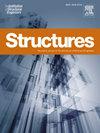涂覆钢纤维钢筋混凝土耐盐冻融性能及损伤演化模型
IF 4.3
2区 工程技术
Q1 ENGINEERING, CIVIL
引用次数: 0
摘要
有害离子侵蚀和冻融循环的耦合效应对寒区混凝土结构的安全性和耐久性提出了重大问题。本研究旨在通过在混凝土中掺入耐腐蚀涂层磨切钢纤维(MSF)来提高这种耦合效应下建筑物的抗剥落性能和使用寿命。在3.5 % NaCl溶液中,对纤维含量分别为0.6 %、1 %和1.4 %的磨切钢纤维增强混凝土(MSFRC)进行了长期的F-T循环。研究了MSFRC的物理力学性能,并利用扫描电镜(SEM)对纤维-混凝土界面的微观形貌进行了评价。结果表明,MSF有助于减轻基体剥落和纤维腐蚀,特别是在纤维含量为1 %的大尺寸结构构件中。随着盐的F-T循环,msf表现出优异的耐腐蚀性和与基体的良好结合,从而减少了F-T循环引起的疲劳损伤。100次盐循环后,试样的抗压和劈裂抗拉强度损失率可保持在25 %以下,破坏模式由基体断裂向韧性断裂转变。建立了基于纤维含量和F-T循环数的强度预测经验公式,R2大于0.98。最后,建立了盐F-T循环作用下MSFRC的损伤模型,为设计MSFRC的使用寿命提供参考。纤维含量为1 %的MSFRC被认为在寒冷的海洋环境中具有最佳的耐久性,可承受高达227次循环。本文章由计算机程序翻译,如有差异,请以英文原文为准。
Salt freeze-thaw resistance and damage evolution model of concrete reinforced with corrosion-resistant coated steel fiber
The coupling effect of detrimental ion erosion and freeze-thaw (F-T) cycles poses substantial safety and durability issues for concrete structures in cold regions. This study aimed to enhance the anti-spalling property and service life of construction under this coupling effect by incorporating the corrosion-resistant coated milled-cut steel fiber (MSF) into concretes. Long-term F-T cycles were performed on milled-cut steel fiber reinforced concrete (MSFRC) of variable fiber content (0.6 %, 1 % and 1.4 %) in a 3.5 % NaCl solution. The physical and mechanical properties of MSFRC were investigated, as well as evaluating the microscopic morphology of the fiber-concrete interface using scanning electron microscopy (SEM). The results indicated that MSF contributed to mitigating the matrix spalling and fiber corrosion, particularly in larger-sized structural members with a fiber content of 1 %. With salt F-T cycling, MSFs exhibited superior corrosion resistance and favorable bonding to the substrate, thus reducing fatigue damage induced by the F-T cycles. The compressive and splitting tensile strength loss rate could be kept below 25 % following 100 salt F-T cycles, accompanied by a transformation in the failure mode from matrix rupture to ductile fracture. Empirical formulae for strength prediction based on fiber content and F-T cycle numbers were developed, with R2 exceeding 0.98. Finally, a damage model was established to serve as a reference for designing MSFRC service life under salt F-T cycles. MSFRC with 1 % fiber content is considered optimal for durability in cold marine environments and can withstand up to 227 cycles.
求助全文
通过发布文献求助,成功后即可免费获取论文全文。
去求助
来源期刊

Structures
Engineering-Architecture
CiteScore
5.70
自引率
17.10%
发文量
1187
期刊介绍:
Structures aims to publish internationally-leading research across the full breadth of structural engineering. Papers for Structures are particularly welcome in which high-quality research will benefit from wide readership of academics and practitioners such that not only high citation rates but also tangible industrial-related pathways to impact are achieved.
 求助内容:
求助内容: 应助结果提醒方式:
应助结果提醒方式:


